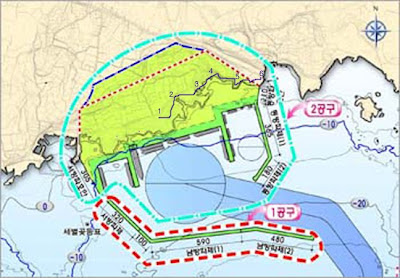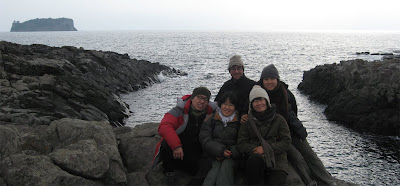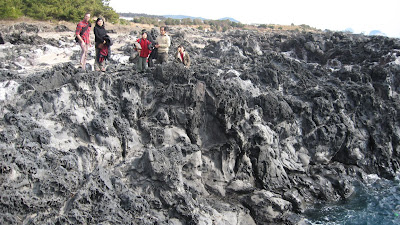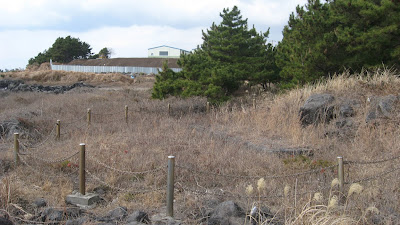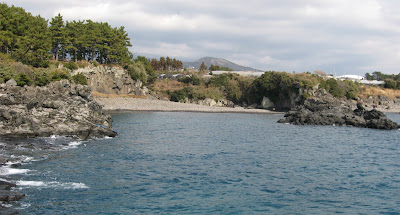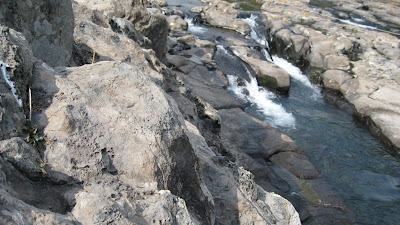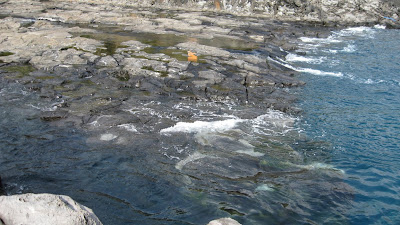Re-post from the No base stories of Korea, Jan. 24, 2011
1. Goorumbee (Gureombi) 구럼비 2. Jinsokkak 진소깍 3. Neobeunyeo 너븐여
4. Gaegoorumbee 개구럼비 (Gaegureombi) 5. Metboori (Moetppuri) 멧부리
6. Gangjeong Stream + Ackeun stream 강정천 + 악근천
………………………………………………………………………….
One can see many Jeju vernacular terms in the names of the places from the Joongduk coast to the Gangjeong Stream. The below is the explanation by Mr. Go Gwon-Il, Gangjeong villager. Saying he could not assert all his explanations were right but based on his knowledge, in case with inference, he gave us some interesting explanations on the names of places.
1. Goorumbee 구럼비
Mr. Go inferred the meaning of the word, ‘bee’ in the ‘Goorumbee’ same with that of the word, ‘bille,’ which means ‘rocks stuck into earth,’ while that of the word, ‘Goorum,’ same that of the word, ‘Gooreum,’ which means ‘cloud,’ therefore the meaning of ‘Goorumbee’ as ‘the rocks of cloud shapes.’
………………………………………………………………………..
2. Jinsokkak 진소깍
The word, ‘So’ in the name of ‘Jinsokkak’ means ‘place of deep water.’ The word, ‘KKak’ means ‘hem of a cloth,’ which is expression of the shape of line that looks like the hem of a cloth on the surface of water into which the bottom parts of the rocks are submerged. Mr. Go said of a tale that has been told in the Gangjeong village for a long time. The story is that when the Seolmoondae Halmang ( ‘halmang’ means ‘old woman’) who is told to have created the Jeju Island in the folktale on the birth of the Jeju Island, lied her body taking the Beom Island (where the UNESCO designated soft corals inhibit underneath) as her pillow and putting her feet into the Baekrokdam ( the crater on the top of Mt. Halla), the Jinsokkak was her womb therefore women who could not have babies long time could have babies if they bath in the end point of the Jinsokkak, where fresh water and sea water meets each other.
……………………………………………………………………
3. Neobeunyeo 너븐여
The word, ‘neobeun’ in the name of the ‘Neobeunyo’ means ‘spacious,’ while ‘yeo’ meaning ‘rock protruded over water.’
…………………………………………………………..
4. Gaegoorumbee 개구럼비
The word, ‘gae’ in the name of ‘Gaegoorumbee’ means ‘the rocks on the ground without being stuck into earth’, different from ‘bille.’
……………………………………………………………………………..
5. Moetboori 멧부리
* On the Metboori, see also HERE 멧부리에 대해서 또한 여기를 클릭하시길
Mr. Go inferred the meaning of the word, ‘Me’ in the name of ‘Metboori’ as ‘the rice on table for religious serves,’ therefore the meaning of ‘Metboori’ as the ‘(sacred) place where people offered rice.’ For reference, there is a low and big stone-made altar where people used to hold the religious service called ‘Byeolpoje,’ since long time ago in theMetboori. The altar is told to directly face toward the direction of rising Sun in March in lunar calendar (which is approximately April in the solar calendar)
The Byeolpoje was an annual religious service held by many villagers for the purpose of good lucks to be prosper, while to prevent bad lucks, around March or April in lunar calendar, which is usually before Danoh (one of big festive days in Korea; the word, ‘Danoh’ means the first five days of May, in lunar calendar) and when the yang energy begins to prosper more than yin energy-it is told that if yang energy is much more than yin energy, the epidemic becomes to be rampant. The Byeolpoje was stopped in 1969 (during the Park Jung-Hee military dictatorship) but resumed in 2002 (the period when the ex-President, Kim Dae-Jung reigned). However as the Island government unilaterally decided over the Gangjeong village as the planned naval base area then the navy purchased the land in 2008, the service was also stopped as the villagers found it was hard to freely walk there.
………………………………………………………………………………
6. Gangjeong Stream + Ackeun stream 강정천 + 악근천
In the seawater of the end point of the Metboori, the fresh water of the Keunnae (means the ‘big stream’ and is also named as the Gangjeong stream) and Akkeunnae (named as the Akkeun Stream) meets with the sea water. One calls the place in the downstream of deep water as ‘Bongdoongiiso.’ There exist the stones called ‘Sokdol’ that has many holes as to drift over water.
One calls the meeting point of the Gangjeong Stream and sea water as ‘Natkkak.’ Its geology is formed of sudden downfall so you can see sometimes water flow that is poured like fall. Because of its clean water, one can see sweet fishes and kind of moss called Polytrichum juniperinum (or pigeon wheat). It is told that there lives the kind of moss called ‘Marchantia polymorpha (called common liverwort or umbrella liverwort) in less clean water.





